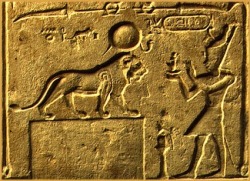
Miysis is the Greek name for Egyptian Mahes. As early as in the Pyramid Texts, Mahes is used in the meaning 'lion', but only from the Middle Kingdom on does the word refer to a deity in theophorous names. After that period the term Mahes is used in this double meaning, lion and lion god.
The cult of the lion god Mahes, son of both Bastet and Sakhmet, was centred on Bubastis and Leontopolis. In the latter he was worshipped as the 'living lion'. As the son of Bastet, he was also worshipped in Wadjet in Upper Egypt. The epithets of Mahes are no different to those of other lion gods. He is usually depicted in two guises - a zoomorphic one and a partially anthropomorphic one.
Mahes's function was that of a war god, guardian of sacred places and destroyer of enemies. When supplied with a sun disk and uraeus he seems to have been associated with and even identified with the sun god.
The cult spread southwards from the older, northern centres. Although probably not widespread before the period from the 22nd to 26th Dynasties, the cult of Mahes grew steadily and was particularly important during the 30th Dynasty. During the Graeco-Roman Period, Mahes was also worshipped in Nubia. It is assumed that the Kushites, as a result of their contacts with Egypt, were stimulated by the many depictions of Mahes, particularly in Philae, and that they identified Mahes with one of the most important figures from their own pantheon, the lion god Apedemak.